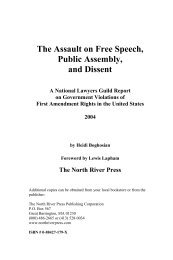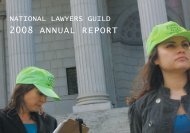GN summer fall09 Digital.indd - National Lawyers Guild
GN summer fall09 Digital.indd - National Lawyers Guild
GN summer fall09 Digital.indd - National Lawyers Guild
- No tags were found...
You also want an ePaper? Increase the reach of your titles
YUMPU automatically turns print PDFs into web optimized ePapers that Google loves.
<strong>Guild</strong> Notes ▪ Summer/Fall 2009Keeping military recruiters away from childrenby Daniel MayfieldIn November 2008 voters in Arcata and Eureka Californiaapproved identical ballot initiatives restricting militaryrecruiters’ contact with youth under the age of 18. In response,the Attorney General of the United States sued both cities onbehalf of the Department of Defense. This spring, without evenhearing oral argument, the U.S. District Court upheld the lawsuitand granted a permanent injunction against the two cities.The federal government brought suit one month later, assertingthat the initiatives subverted its right to raise an army.It also argued that the voter-approved restrictions on thecontact between military recruiters and minors were illegalbecause they “purport to authorize the cities to directly regulatethe activities of the federal government.” The increasedrestrictions are illegal, the government claimed, because theUnited States has greater authority than any city under ArticleIV, Section 2 of the Constitution, more commonly referred toas the Supremacy Clause.The cities argued that the issue was not as simple as theU.S. attorney asserted. <strong>Guild</strong> attorneys Dennis Cunninghamrepresented the City of Eureka, and Michael Sorgen assistedthe attorneys for the City of Arcata, Minami & Tamaki.Sharon Adams represented the initiative proponents andsought to intervene in the case. Defendants responded tothe government’s claims by arguing that the cities had theright—indeed the duty—to protect their citizens, noting thatthe cities clearly had the right to protect young people fromother harmful influences and that the ordinance only affectedpeople under the age of 18.The cities and the voters contended that parents shouldhave greater control over access to their children than themilitary, stating in part:“The very statutes which Plaintiff claims preempts thelocal ordinances here openly acknowledge the right of parentsand local authorities to limit military recruiter access tostudents ... Thus, Congress placed parental rights above theinterests of military recruiters.”However, the Court ignored this argument entirely andbased its decision on the Supremacy Clause.Defendants also argued that parents should have greaterauthority over the lives of their children than the federalgovernment. They noted that neither ordinance prohibitedmilitary recruiting completely. Instead the recruiters wereconfined (in Arcata and Eureka) to talking to those peoplewho were of voting age. The U.S. government disagreed withthis assertion on the grounds that it is unconstitutional to givelocal families an authority reserved for the state.The defendants also argued that the Supremacy Clauseis not violated since that Clause gives equal weight to treatiessigned by the U.S. The U.S. is a signatory to the “OptionalProtocol” to the Conventions of the Rights of the Child. TheProtocol specifically prohibits military recruiting of youthunder age 18. The U.S. signed with a reservation, prohibitingmilitary recruitment of youth under age 17.Despite these already existing restrictions, military recruitershave a history of targeting youth. Recruiters are encouragedin their own training manuals to contact minors. Programs suchas the JROTC and the Middle School Cadet Corps are in manyschools and allow contact between minors and the military wellbefore the age of 17. In addition, recruiters are encouraged tobecome volunteer coaches at middle schools and high schoolsso that they can have close, unsupervised contact with youth.Unfortunately, the U.S. District Court ignored alldefendants’ arguments. Judge Armstrong did not allow theproponents to intervene, stating that the Cities adequatelyrepresented their views. Then, she dismissed the Cities’counter-claims, holding that the Cities could not articulate a“particularized injury.” Defendants argued that the proponentmembers could and did state particularized injury, but theCourt ignored this and dismissed the counterclaims. In a similarfashion, the Court simply took the government’s position,without even analyzing U.S. obligation under the OptionalProtocol, or parental rights under the 10th.Other avenues of attack still exist for local control overrecruiters. Other cities are interested in similar initiative measures,which will be drafted to overcome the arguments madeby the U.S. in this case.Sharon Adams notes that current U.S. law is essentiallyin compliance with the Optional Protocol, because both U.S.law and the Optional Protocol discuss “recruiting” of youthage 17 or older. The Cities contended that Congress intendedrecruitment be directed toward youth age 17 or older. Astoundingly,the U.S. attorneys argued that the U.S. militaryrecruiters are not “recruiting” when they are speaking toyouth under 17; they are, the government argued, communicatingwith youth “for the purpose of encouraging their latervoluntary enlistment in the armed forces.”Kathy Gilberd of the Military Law Task Force feels thatthe real issue here is not whether the cities or the voters canwin in the courts, but rather the key issue is the attempt toassert local control over the ability of the U.S. Governmentto recruit youth. “There is no down side to the local controlof recruiters issue,” said Kathy. “We should raise this issuewith the voters, with the schools, and with parents in everypossible way.”The Military Law Task Force is planning a workshop forthe Seattle Convention on these issues. Speakers will addresslocal control as well as working with teachers and schoolboards to limit recruiter access to youth. Finally speakers willaddress how to use the No Child Left Behind Act to build amovement in the schools to cut off recruiter access to names,addresses and dates of birth of high school students. □▪ 10 ▪


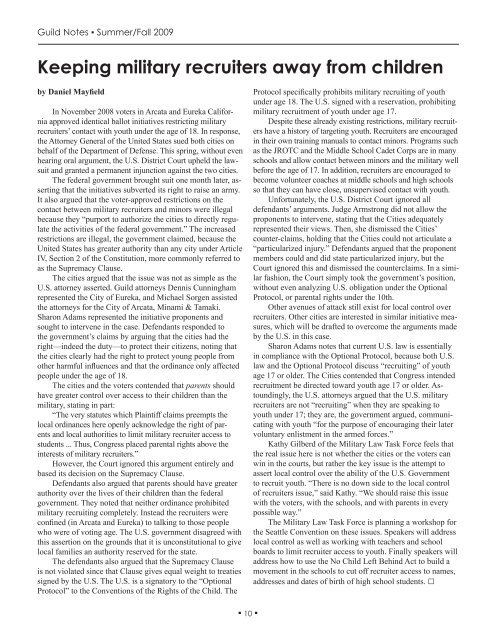
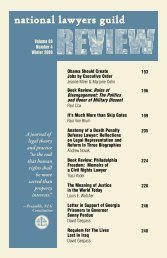
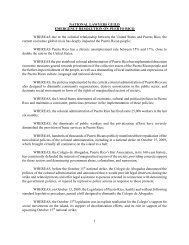
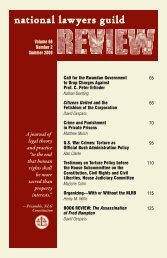
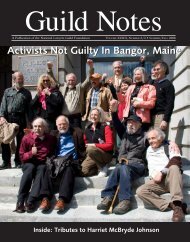
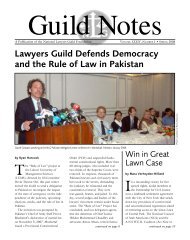
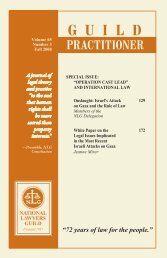

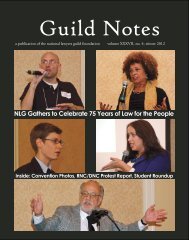

![NLGRev 68-2[1].indd - National Lawyers Guild](https://img.yumpu.com/30820772/1/167x260/nlgrev-68-21indd-national-lawyers-guild.jpg?quality=85)
